 Category: Wine
Category: Wine
Tim Mondavi and Cabernet Franc
We’ve been pretty sure for a while now that Cabernet Franc was a good bet for our small vineyard. It’s a wonderful grape for blending, often used to soften the harsh tannins in its close cousin, Cabernet Sauvignon, and it is lovely on its own as a varietal. And we’ve tasted it at enough wineries in enough different parts of the state to believe that it’s well suited to the growing conditions found in Virginia.
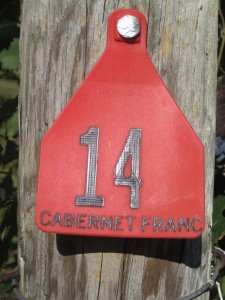 It is (usually) the dominant grape in Cheval Blanc, one of the great wines of Bordeaux. It is not a first growth, since Saint-Emilion was not included in the 1855 classification, but in the 1955 Saint-Emilion classification, it was one of two ones to be ranked as a "Premiers Grands Crus Classés A." And, of course, the 1961 Cheval Blanc was the wine that Miles had hidden away for a special occasion in Sideways. (He drank it from a paper cup at the end while at a McDonalds, since his love interest had told him that — and I'm paraphrasing from memory — any time you drink a Cheval Blanc, it's a special occasion.)
It is (usually) the dominant grape in Cheval Blanc, one of the great wines of Bordeaux. It is not a first growth, since Saint-Emilion was not included in the 1855 classification, but in the 1955 Saint-Emilion classification, it was one of two ones to be ranked as a "Premiers Grands Crus Classés A." And, of course, the 1961 Cheval Blanc was the wine that Miles had hidden away for a special occasion in Sideways. (He drank it from a paper cup at the end while at a McDonalds, since his love interest had told him that — and I'm paraphrasing from memory — any time you drink a Cheval Blanc, it's a special occasion.)
For those of you willing to spend upwards of $1,000 a bottle (and more) on a Cheval Blanc, I have no doubt you will feel the money well spent. But if you do, then don’t hesitate to invite me to share it with you. I’ve never tasted Cheval Blanc, but I’ve certainly lusted over the thought.
However, if you are among the 99 – make that the 99.9 – who can’t afford Cheval Blanc, you should think about a Virginia wine that is either entirely Cab Franc or included as the dominant grape in a blend. Almost every winery in Virginia seems to have a Cab Franc in its tasting room, and many of them are splendid.
But while we’re sold on Cab Franc, it’s always nice to hear that others feel the same way. In the Nov. 15 issue of The Wine Spectator, a lengthy article on Tim Mondavi includes a sidebar (The Francophile in Continuum,) that highlights this great winemaker's love for Cab Franc.
"The wines that had the highest percentage of Cabernet Franc were the wines I loved the most," says Tim. "When I would be looking at the wines in barrel, I found there was a higher perfume [in Franc] that was very different from Cabernet Sauvignon. It also adds viscosity and suppleness you can't find with Cabernet Sauvignon or Merlot."
Franc does need to be ripe, the Wine Spectator adds. “Otherwise it can be herbal, stalky and coarse.”
That’s precisely the problem that some identify in Virgina reds – vegetal flavors, usually produced by a compound known as methoxypyrazine that comes from grapes that are not quite ripe. The risk is especially pronounced in areas with short growing seasons or in years when rain or other conditions force an early harvest. Done right, Cab Franc can be wonderful, in Virginia wines as well as in Mondavi’s Continuum.
In another four years, after the vines have matured, the grapes have been picked and fermented, and the wine has been in the bottle for a suitable period of time, I’ll be able to tell you how well it worked out.
Bringing in the Grapes — Part V
Readers of ProjectSunlight have noted a recurring theme over the past month. The weather, at least insofar as vineyard mangers in Virginia are concerned, really sucked this year.
It may be small comfort to the Commonwealth’s vignerons, but the weather has generally sucked worldwide. Jancis Robinson, in her Financial Times column last weekend, detailed the carnage in California and Europe, and even in the Southern Hemisphere, where the growing season is reversed.
“If Europe’s vintners have found 2011 much more trying than any other recent vintage, six months earlier, while picking their 2011s, the Australians experienced the vintage from hell,” she wrote. “Harvest time in the supposedly sunny wine state of South Australia was sodden. Winemakers have had to work extremely hard in some areas to fashion drinkable wine out of bloated, rotten grapes.”
And it goes beyond Australia. “The vintage in New Zealand was bloated too, thanks to frenzied recent planting of vines there, fuelled by a belief that the world is in love with Kiwi Sauvignon Blanc,” she added. “Argentine growers were also afflicted by rain at harvest time in 2011, as well as the usual hail, and unusually late frost in November last year.”
So, weather-related problems span the globe. As I’ve noted before, that’s the way it is with agriculture. You really have no control over the weather, although you can compensate to some extent – to a great extent in normal years, less so in years like 2011 – with a disciplined spraying program.
And winemakers can exert some magic of their own once the grapes come in. This year will be difficult for sure, and none of the winemakers I’ve spoken to have any illusions about the challenges ahead of them. This vintage will definitely separate the men from the boys, so to speak, and show, as Ms. Robinson said, “who exactly are those master craftsmen.”
WBC11 – A Conference for Wine Bloggers
I’ve been meaning for a week now to write something about the Wine Bloggers Conference (WBC11) that was held in Charlottesville July 22-24. It was a well-planned, well-executed conference, but what I think was most important about it for the purpose of this blog is the way it showcased Virginia’s wine industry. Some 325 bloggers from around the country attended, and they were all exposed in a variety of ways to Virginia wine.
While I was gathering my thoughts, I had occasion to read two really terrific posts from Frank Morgan on his blog, "Drink What You Like." I started to respond to the post, and my piece turned out to be too long for a comment – probably too long for a blog post, for that matter – so I decided to submit a trimmed-back version to his blog and run the extended piece here. If you haven’t yet seen Drink What You Like, trust me, it’s well worth a visit.
What’s great about these two posts (A View from the Punt, I and II) is the perspective it provides from “the other side of the bottle” – the views of those who were pouring their wines at this conference. I had actually been wondering what the winemakers, vineyard managers, marketing directors and others who poured during the conference thought about the event and about the bloggers. They pour (sorry for the pun) their lives into their wines, then pour the wines for people who sniff and swirl it for a few moments before rendering judgments that can be generous in their praise or critical to the point of being mean-spirited. Continue Reading–>
Not just a tasting room: Touring Sonoma’s Wine Valleys
Last week, the UPS truck brought a box of wine from California, reminding me just how late I am in writing something about our tour of Sonoma's Russian River and Dry Creek Valleys. The box contained bottles we had purchased in visits to five separate vineyards, and each told its own story — one of terroir, another of organic viticulture methods, and yet another of vines that were planted in the century before the last one.
It was a wonder that we ended up collecting any of these bottles and their stories. When we first 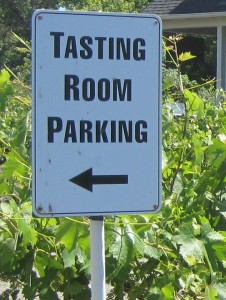 started planning the tour, I had thought we might visit some of the vineyards that make wines I know and like, such as Simi, a Healdsburg-based winery that makes a Cab I enjoy. But we signed up with Valley Wine Tours, and in the weeks leading up to the trip, I exchanged a series of emails with our tour guide, Bob Howells, who helped me think through the options. "We can go there," he said about one of my choices. "But it's just a tasting room."
started planning the tour, I had thought we might visit some of the vineyards that make wines I know and like, such as Simi, a Healdsburg-based winery that makes a Cab I enjoy. But we signed up with Valley Wine Tours, and in the weeks leading up to the trip, I exchanged a series of emails with our tour guide, Bob Howells, who helped me think through the options. "We can go there," he said about one of my choices. "But it's just a tasting room."
That made sense. We were looking for something more than another tasting room experience. As we get closer to planting vines (beyond the 14 experimental vines we are tending on two different properties), our primary focus is on educational opportunies.
Martinelli converted this lovely barn into a tasting room.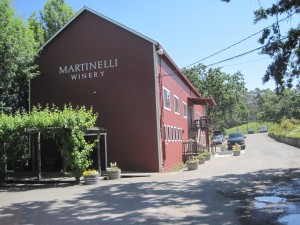
What we were looking for on this trip were wineries where we'd have an opportunity to chat with winemakers, vineyard managers and owners. Until my email exchange with Bob, it hadn't occured to me that we wouldn't get that at the larger wineries that ship back to the east coast.
After providing that bit of counsel, Bob was extremely helpful in planning our itinerary. I was particularly interested in three Sonoma AVAs — the Alexander Valley, Dry Creek Valley and the Russian River Valley — and he provided a list of six vineyards for each. After a couple of hours of research at Total Wines in Chantilly, I discovered that the wines from these vineyards were generally not available in stores on the east coast.
So far, so good, then. We would visit wineries that we would otherwise never experience. We decided to eliminate Alexander Valley, even though it is a great terroir for Cabernet, my favorite grape varietal. We couldn't do all three, and Bob said it would be easier to get the experience we were looking for in the other two AVAs. And he promised we would have an opportunity to discuss wine with knowledgable people who are passionate about what they do.
We visted five wineries that day: Martinelli Winery, Inman Family Wines, Battaglini Estate Winery, Talty Vineyards and Winery, and Truett-Hurst Vineyards. We loved them all, each for different reasons and each because it contributed in a different way to our education. Martinelli, for example — perhaps the largest of the vineyards we visited — was all about terroir. The Martinelli family has more than 300 acres planted, but only 15 percent goes to their own labels, while the rest is sold to other wineries. We tasted Chardonnays from three separate vineyards that are part of their property, and each was distinctly different. The Woolsey Road vineyard, for example, is a packed-clay soil, and the wine had pronounced mineral notes, while the Three Sisters vineyard, more of a sandy loam soil, featured a much softer, more buttery Chard.
While I liked all five vineyards, I'll focus on two here, Inman and Battaglini. Both were extemely generous with their time, and both offered the kind of unique educational experience we were seeking.
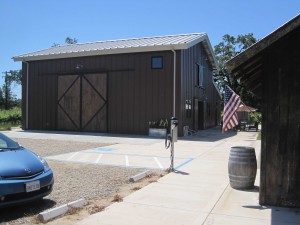
- Inman Family Wines is a small, family-run vineyard and winery focused on the production of elegant Pinot Noirs.
We bumped into Kathleen Inman even before we got into the winery. She was busy arranging outdoor furniture to prepare for the day's visitors, but she took out an hour of her time out to talk to us about the vineyard. Kathleen is big into organic viticulture, and she discussed the organic sprays they use, which are not as easy to find as the non-organic variety and significantly more expensive. Some of the vineyard consultants I've talked to back on the east coast are dismissive of organic sprays, but Kathleen is getting great results.
We spent some time talking about canopy management, including her determination to remove all lateral shoots from the vines. Laterals are extraneous shoots situatued just above a leaf, which are in a sense "a shoot coming out ot a shoot." The leaf is valuable, since it contributes to photosynthesis. The lateral simply drains energy from the vine. In addition, removing laterals provides a bigger bang for the buck when thinning the canopy. Pulling a lateral removes three or more leaves at once, compared to the removal of a single leaf. Kathleen also showed us the equipment she uses to make "compost tea," a liquid brewed from compost that can be used to add nutriets to the soil or to protect the canopy from disease.
One surprise: To the maximum extent possible, Inman uses natural yeasts, the yeasts that are present on the skin of the grapes. Many, perhaps most winemakers, prefer to kill the natural yeast with potassium metabisulphite, and then add a specific commerically-made yeast to start the fermentation. I don't think I would have the courage to rely on natural yeasts, but after tasting the wine, I don't see how anyone can argue with Kathleen's methods.
And yes, we finally did get around to tasting. We were thrilled in particular with the Pinots, which were lush and balanced with nice acidity — perfect for food. Pinot Noir is one of the most difficult grapes to grow, and Kathleen's passion for Pinot Noir is clearly evident in her wines. In addition to some Chardonnay, we purchased the 2007 Thorn Ridge Pinot Noir. While I don't pretend to have the world's most sophisticated sense of smell or taste, I picked up blackberry and dark fruit on the nose, and tasted dark cherry in particular on the palate. A fabulous Pinot.
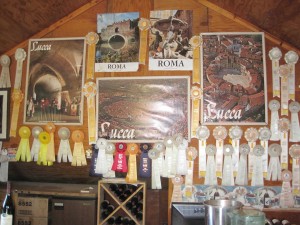
- Joe Battaglini's tasting room looks like a page out of a history book. Nothing fancy, but the wine and Joe's company are what counts here.
At Battaglini, we tasted Zinfidels that gave new meaning to the words, "old vine." Owner Joe Battaglini, who hails originally from Luca, Italy, purchased 30 acres in the Russian River valley in 1998, inheriting vines that are now 126 years old.
This is a one-of-a-kind operation. The tasting room is a small corner of what appears to be an old shed, decked out with pictures of Luca, Rome and other Italian cities, plus the many ribbons he's won in wine competitions over the years. After tasting, and before lunch, which we ate at a shaded table outside the tasting room, Joe took us on a tour of the vineyard. The old vines produce very little in the way of grapes, and a corporate-owned winery would have torn them out years ago in favor of young, higher-productivity vines. Joe dotes on his old vines, even giving them names. One, for example, looks like a huge chair, and so Joe named it "the throne."
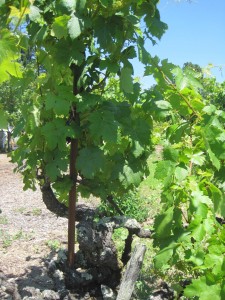 The first thing you notice about the old vines is the lack of trellising. "That's how it was done back then, and how it was when I bought the vineyard," he said. "I didn't want to change anything."
The first thing you notice about the old vines is the lack of trellising. "That's how it was done back then, and how it was when I bought the vineyard," he said. "I didn't want to change anything."
Of course, some things are changing. A modern tasting room is under construction. I suppose it will serve the needs of the winery better, but I can't help but think it will lack the charm of the little shed with the bar and the photos, which remains locked until visitors show up and Joe comes out to greet them. The winery itself is also modern, and after we finished eating the picnic lunch Bob had brought for us, Joe popped out again and offered us a tour.
At the winery, you can choose from 28 Zinfandels, six Petite Sirahs and four Chardonnays. Not a bad selection. We bought a half dozen Zins, and have already enjoyed one. They're ageworthy, but I doubt they'll get that opportunity.
Me, Joe and the Vineyard Goddess, after a tasting.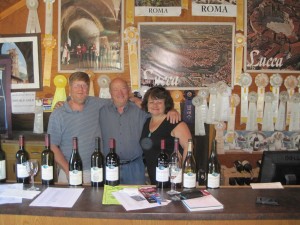
Finally, returning to the sub-theme of this post, the afternoon before this tour, we passed by the Benziger Family Winery after a visit to the Jack London state park (which includes a great museum, with lots of history related to this uniquely American writer) and decided to stop in. We've been there once before, and enjoyed it thoroughly. On our last visit, we took advantage of the tram tour, which shuttles you through the vineyard and on to the crush pad, the fermentation facility and the barrel caves. If you don't take the tram tour, you can still wander through the biodynamic vineyard exhibit, a garden-like setting that explains the vinyeard's green approach to growing grapes.
This time, we arrived shortly before closing, and had time for a tasting only. It was $10 (perhaps a bit steep?), but the wines were good and the setting quite pleasant. Our server was articulate and friendly, and I asked him how long he had been working at Benziger. Thirteen weeks, he said, which explained why he didn't know much more than might have been contained on a script. He wasn't bad, by any means, just not knowledgeable enough to go beyond some basics on each of the wines.
Benziger: It's hard to imagine a more beautiful vineyard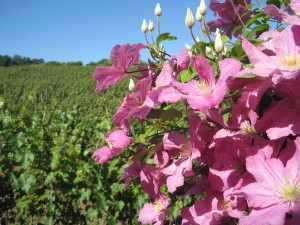
Which made me realize, a day before we began our tour, how right Bob had been in steering me away from a winery I loved that would have been "just a tasting room," in favor of experiences I'll remember for the rest of my life.
A Trio of Virginia Wineries
I'm planning to add some reviews of the wineries I like, but that will take a bit more time than I have today. So, for now, I'm just going to offer a list of three wineries in the Monticello AVA that I am particularly fond of. And there is a theme here: these are the three wineries who came together to make a wine they named (appropriately enough) "3."
Emily Pelton of Veritas Vineyards stands behind bottles of "3" wine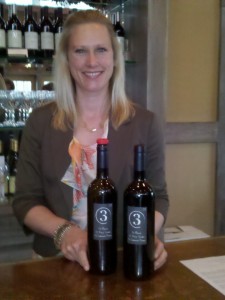
Each of the three contributed one of the varietals to the blend. Pollak Vineyards provided the Petit Verdot, Veritas Vineyard and Winery supplied the Cab Franc, and King Family Vineyards contributed the Merlot grapes. In theory, they planned to blend one third each of the grapes, but in practice, I think they realized that a blend required some judgment, and would likely end up being something other than one-third each. When blending wines, as I learned from King Family winemaker Matthieu Finot, you spend a lot of time experimenting and tasting. In this particular blend, I'm guessing that the Petit Verdot was very powerful, and they may have decided to use less of it and more of either of the other two grapes.
No matter. The wine was fabulous, and since they only made 150 cases, it sold out quickly. Each customer at Veritas was limited to three bottles at $33.33 each — yes, they carried the 3 theme pretty far — and I personally think this one will age quite well. So my three bottles are stored in my EuroCave wine celler, waiting for that perfect moment in the near future when they will achieve perfection.

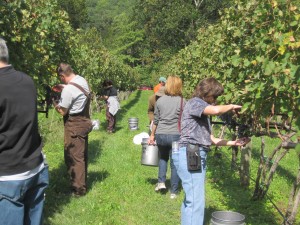
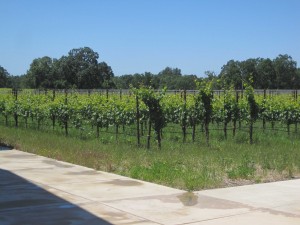
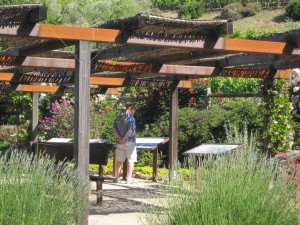


Recent Comments